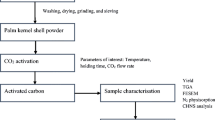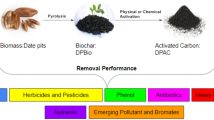Abstract
Palm oil production is vital for Asian countries economy. Substantial amount of oil palm waste yielded has created significant disposal problem. One of the mitigate approaches involves usage of these wastes as activated carbon precursor. This work introduces concurrent activation and modification (CAM) to synthesize palm kernel shell–derived activated carbon (PKSdAC) with sulfuric acid (H2SO4) and barium chloride (BaCl2) as activating and modifying agent. Assessment of CAM-PKSdAC production economic viability is investigated in terms of capital cost, production cost, net present value (NPV), return on investment (ROI), and payback period (PBP). CAM process of PKS facilities to produce 2313 kg AC/day requires a total fixed capital investment of $13.37 million and production cost of $4.83 million with estimated product cost of $6.53 per kg. CAM-PKSdAC production estimates an NPV of $1.08 million with annual 0.13% ROI and 2.77 years PBP, whereas a conventional single-step H2SO4 activation and subsequent BaCl2 modification process of PKS facilities require $16.30 million fixed capital investment and production cost of $5.40 million annually with estimated product cost of $5.73 per kg. Conventional surface modified-activated PKSdAC production estimates a negative NPV of − $0.14 million with annual 0.13% ROI and 3.02 years PBP.


Similar content being viewed by others
Data availability
This declaration is not applicable.
References
Awalludin MF, Sulaiman O, Hashim R, Nadhari WNAW (2015) An overview of the oil palm industry in Malaysia and its waste utilization through thermochemical conversion, specifically via liquefaction. Renew Sust Energy Rev 50:1469–1484
Lee XJ, Lee LY, Gan S, Thangalazhy-Gopakumar S, Ng HK (2017) Biochar potential evaluation of palm oil wastes through slow pyrolysis: thermochemical characterization and pyrolytic kinetic studies. Bioresour Technol 236:155–163
Loh SK (2017) “The potential of the Malaysian oil palm biomass as a renewable energy source”, Energy Convers. Manage 141:285–298
Omar R, Idris A, Yunus R, Khalid K, Aida Isma MI (2011) Characterization of empty fruit bunch for microwave-assisted pyrolysis. Fuel 90(4):1536–1544
Yusoff S (2006) Renewable energy from palm oil – innovation on effective utilization of waste. J Clean Prod 14(1):87–93
Caicedo-Salcedo OD, Vargas-Delgadillo DP, Giraldo L, Moreno-Piraján JC (2019) Data of preparation and characterization of activated carbon using two activant agents and mango seed as precursor material. Data Brief 27:1–9
Vargas DP, Giraldo L, Moreno-Piraján JC (2016) Characterisation of granular activated carbon prepared by activation with CaCl2 by means of gas adsorption and immersion calorimetry. Adsorption 22(4):717–723
Zanella O, Tessaro IC, Féris LA (2014) Study of CaCl2 as an agent that modifies the surface of activated carbon used in sorption/treatment cycles for nitrate removal. Braz J Chem Eng 31(1):205–210
Ajani AO, Dada EO, Olu-arotiowa OA, Okeowo I (2019) Adsorption of methylene blue from aqueous solution using microwave-assisted BaCl2 modified activated carbon produced from mango seed shell. LAUJOCES 3(1):72–82
Rashid RA, Jawad AH, Ishak MABM, Kasim NN (2018) FeCl3-activated carbon developed from coconut leaves: characterization and application for methylene blue removal. Sains Malays 47(3):603–610
Cazetta AL, Pezoti O, Bedin KC, Silva TL, Paesano Junior A, Asefa T, Almeida VC (2016) Magnetic activated carbon derived from biomass waste by concurrent synthesis: efficient adsorbent for toxic dyes. ACS Sustain Chem Eng 4(3):1058–1068
Bedia J, Peñas-Garzón M, Gómez-Avilés A, Rodriguez JJ, Belver C (2020) Review on activated carbons by chemical activation with FeCl3. C 6(2):1–25
Ben-Mansour R, Habib MA, Bamidele OE, Basha M, Qasem NAA, Peedikakkal A, Laoui T, Ali M (2016) Carbon capture by physical adsorption: materials, experimental investigations and numerical modeling and simulations – a review. Appl Energy 161:225–255
Tsuchiya T (2018) Van der waals force. In: White WM, Casey WH, Marty B, Yurimoto H (eds) Encyclopedia of geochemistry. Springer, Cham
Ng C, Marshall WE, Rao RM, Bansode RR, Losso JN (2003) Activated carbon from pecan shell: process description and economic analysis. Ind Crop Prod 17(3):209–217
Nowrouzi M, Younesi H, Bahramifar N (2017) High efficient carbon dioxide capture onto as-synthesized activated carbon by chemical activation of Persian Ironwood biomass and the economic pre-feasibility study for scale-up. J Clean Prod 168:499–509
Pramanik P, Patel H, Charola S, Neogi S, Maiti S (2021) High surface area porous carbon from cotton stalk agro-residue for CO2 adsorption and study of techno-economic viability of commercial production. J CO2 Util 45:1–12
Kayiwa R, Kasedde H, Lubwama M, Kirabira JB (2021) The potential for commercial scale production and application of activated carbon from cassava peels in Africa: a review. Bioresour Technol Rep 15:1–15
Liu L, Qian HL, Mu LW, Wu J, Feng X, Lu XH, Zhu JH (2021) Techno-economic analysis of biomass processing with dual outputs of energy and activated carbon. Bioresour Technol 319:1–8
Peters M, Timmerhaus K (1991) Plant design and economics for chemical engineers. McGraw-Hill, New York
McCabe WL, Smith JC, Harriott P (1993) Unit Operations of Chemical Engineering, 5th edn. McGraw-Hill, Singapore
Minimum-Wage (2021) Malaysia minimum wage rate 2021. https://www.minimum-wage.org/international/malaysia. Accessed 13 Sept 2021
Statistics, USBoL (1988) Monthly labor review. Government Printing Office, U.S
Sinnott RK (2005) Coulson & Richardson’s chemical engineering, 4th edn. Elsevier Butterworth-Heinemann, Oxford
Ministry of Utilies Sarawak, Sarawak Government (2018) Water consumption analysis in Sarawak. https://data.sarawak.gov.my/home/data/dataset/08269c9e-21f9-46d8-979d-54db919fd74c. Accessed 23 Aug 2021
Ong S, The Edge Communications Sdn. Bhd (2021) High energy costs reach local shores, average natural gas price up 21%. https://www.theedgemarkets.com/article/high-energy-costs-reach-local-shore-average-natural-gas-price-21. Accessed 13 Nov 2021
Sarawak Energy (2020) Tariffs-industrial pricing & tariff. https://www.sarawakenergy.com/customers/tariffs. Accessed 6 Mar 2020
Malaysian Palm Oil Council (MPOC) (2021) Growth of Malaysian palm kernel shell in Japan. http://mpoc.org.my/growth-of-malaysian-palm-kernel-shell-in-japan/. Accessed 13 Sept 2021
Suruhanjaya Tenaga (Energy Commission) (2016) Peninsular Malaysia piped gas distribution industry outlook 2016:1–48. https://www.st.gov.my/ms/contents/publications/outlook/Peninsular%20Malaysia%20Piped%20Gas%20Distribution%20Industry%20Outlook%202016.pdf. Accessed 13 Sept 2021
Camaraza-Medina Y, Sánchez-Escalona AA, Retirado-Mediaceja Y, García-Morales OF (2020) Use of air cooled condenser in biomass power plants: a case study in Cuba. Int J Heat Technol 38:425–431
Alibaba (2022) 1000–1400mg/G 30X60 mesh coconut shell activated carbon for car air purifier. https://www.alibaba.com/product-detail/1000-1400mg-G-30X60-Mesh-Coconut_1600475611237.html?spm=a2700.details.0.0.254a45473fjHPs. Accessed 14 Oct 2022
Fortune Business Insights (2022) Activated carbon market size, share & COVID-19 impact analysis, by type (powdered, granular, and others), by application (water treatment, air & gas purification, food & beverage, pharmaceutical & healthcare treatment, and others), and regional forecast, 2022–2030. https://www.fortunebusinessinsights.com/activated-carbon-market-102175. Accessed 14 Oct 2022
Acknowledgements
This research was pursued under the support by Yayasan Sarawak Tun Taib Scholarship.
Author information
Authors and Affiliations
Contributions
This declaration is not applicable.
Corresponding author
Ethics declarations
Ethical approval
This declaration is not applicable.
Conflict of interest
The authors declare no competing interests.
Additional information
Publisher's Note
Springer Nature remains neutral with regard to jurisdictional claims in published maps and institutional affiliations.
Appendix. Estimated capital cost and operating cost for PKSdAC production
Appendix. Estimated capital cost and operating cost for PKSdAC production
Table 7
Table 8
Rights and permissions
Springer Nature or its licensor (e.g. a society or other partner) holds exclusive rights to this article under a publishing agreement with the author(s) or other rightsholder(s); author self-archiving of the accepted manuscript version of this article is solely governed by the terms of such publishing agreement and applicable law.
About this article
Cite this article
Lai, J.Y., Ngu, L.H. Techno-economic feasibility study for concurrent activated and modified palm kernel shell–derived activated carbon. Biomass Conv. Bioref. (2022). https://doi.org/10.1007/s13399-022-03520-y
Received:
Revised:
Accepted:
Published:
DOI: https://doi.org/10.1007/s13399-022-03520-y




